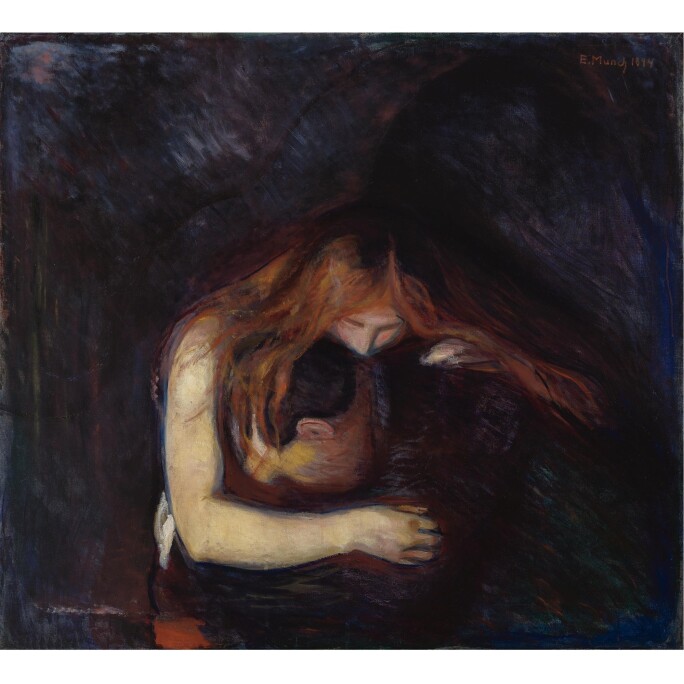Edvard Munch’s masterpiece The Scream (1895) is one of the world’s most recognizable artworks and a stunning vision of existential loneliness and anguish made on the eve of what would become Europe's most violent century. The wrenching scene of a wraith-like figure shielding its ears from the scream of nature would come to inspire the creation of the Expressionist art movement and has become an icon of the Modern Age.

At the end of the 19th century, around the same time Austrian psychologist Sigmund Freud initiated his investigations of the subconscious mind, Norwegian artist Edvard Munch began to create unconventional paintings, often of sickness and death, that attempted to plumb the unsettling depths of human emotion and pain.
The Scream itself belongs a series of works entitled The Frieze of Life, which Munch began in the late 1800s and which included 22 works by the time they were exhibited together in Berlin in 1902. In its entirety the ambitious series depicts evocative and often fraught moments relating to love, loss, death and spirituality and though the works draw from Munch’s personal experience — the figures and themes are universal.
"There was blood and tongues of fire above the blue-black fjord and the city—my friends walked on, and I stood there trembling with anxiety—and I sensed an endless scream passing through nature"
Throughout the series Munch would create four versions of The Scream, which he had originally titled Der Schrei der Natur ("The Scream of Nature"). The artist had first tried to capture the brutalizing cosmic anxiety in a prose poem, writing, “I was out walking with two friends—the sun began to set—suddenly the sky turned blood red—I paused, feeling exhausted, and leaned on the fence—there was blood and tongues of fire above the blue-black fjord and the city—my friends walked on, and I stood there trembling with anxiety—and I sensed an endless scream passing through nature.”

The Scream is often considered the culmination of Munch's career, channeling Symbolism and emotionalism into a revelatory psychological vision that captured the tension and anxiety of life at the end of the last century. Though made over a century ago, the resonance of this harrowing image remains powerfully contemporary. The central, emaciated figure's now- iconic gesture — of covering its ears and its mouth agape — has been mimicked countlessly in popular culture from an episode of The Simpsons to the movie poster for Home Alone (1990). When Sotheby’s offered the last version of The Scream in private hands in its November 2012 Impressionist & Modern evening sale, five competing bidders vied to win the iconic image, driving the price to an exponential $120 million dollars, then the highest price ever paid for a work at auction. Four years later in 2016, another triumph of Munch’s career Pikene på broen (The Girls on the Bridge) of 1902 reached an impressive $54.5 million.
The artist's foreboding aesthetic was undoubtedly shaped by his painful life story. Born in 1861 in what is now Norway, Munch was the son of a medical officer and his wife and the second of their five children. Their mother died of tuberculosis in 1868 and their father raised the children amid an atmosphere of dark religiosity and superstition. This morbid childhood environment became the foundation of Munch’s artistic practice with his siblings, especially his sister Sophie, who died of tuberculosis in 1877, appearing regularly throughout his oeuvre. His aesthetic was also influenced by nihilist Han Jaeger who had encouraged Munch to explore his own psychological state and memories in his artworks.
The years around the turn of the century, soon after The Scream's completion, saw Munch’s first critical and financial successes. Despite his turn toward good fortune, the artist was plagued by psychological instability and suffered a nervous breakdown in 1908. Though Munch recovered and continued to work he spent nearly the last two decades of his life in solitude living outside Olso until his death at the age of 80 in 1944.
Upon his death, Munch’s remaining works were bequeathed to the city of Oslo to form the Munch Museum, the largest collection of works by the artist in the world. His work was exhibited extensively in Germany during his lifetime, and an entire generation of Expressionist artists including Max Beckmann and Ernst Ludwig Kirchner as well as Austrian artists Egon Schiele and Oskar Kokoschka were directly inspired by his unique style. Recently, in 2017 Munch was the subject the landmark exhibition Edvard Munch: Between the Clock and the Bed held at the Met Breuer, New York, which has helped to reinvigorate critical discourse around this singular artist and his lasting influence on contemporary art.








